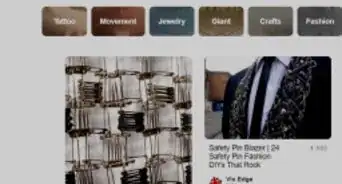This article was co-authored by Janet Peischel. Janet Peischel is a Writer and Digital Media Expert and the Owner of Top of Mind Marketing. With more than 15 years of consulting experience, she develops content strategies and builds online brands for her clients. Prior to consulting, Janet spent over 15 years in the marketing industry, in positions such as the Vice President of Marketing Communications for the Bank of America. Janet holds a BA and MA from the University of Washington.
There are 7 references cited in this article, which can be found at the bottom of the page.
wikiHow marks an article as reader-approved once it receives enough positive feedback. This article received 17 testimonials and 81% of readers who voted found it helpful, earning it our reader-approved status.
This article has been viewed 1,042,419 times.
A great logo is more than images and words, a good logo tells a story about your company--who you are, what you do and what you stand for. That's a lot to ask of one piece of art, which is why it's important that you take the time to do it right. Fortunately, you don't have to do it alone. The steps below will take you through the process of designing a logo that will successfully brand you in the marketplace.
Steps
Brainstorming
-
1Determine the primary function of your logo. A logo represents your brand through the use of shape, fonts, color and images. Being clear on why you need a logo can guide your design.
- Boost recognition. Is your company new or competing in a field with a lot of other players? Having a strong logo can help clients recognize your brand more readily.
- Create memorability. Consumers shop with their eyes and logos can be easier to remember than names, products, and services. Over time, a customer comes to associate your logo with your company.
- Create trust. Part of bringing in and keeping clients is based on their willingness to trust you. A solid logo that conveys your honesty and integrity can help put clients at ease.
- Enhance admiration. If clients already have a good impression of your business, you can build on that by creating a logo that is well-regarded for its good looks, cleverness or effective simplicity.
-
2Think about your target market. It's important to be clear on who your client is and customize the look of your logo to appeal to those who will be using your services.
- A logo for a florist shop could incorporate a whimsical font and a bright color scheme; this wouldn't work so well for an auto body repair garage.
- A logo for a law firm must communicate integrity and strength; not necessarily the look that would work well for a catering company.
Advertisement -
3Decide whether to incorporate your company's name into the logo. Of course, you want to build name recognition for your business, but making the name part of your logo design may not always be a good idea.
- Include the name if it is reasonably distinctive but not yet a household word or if your marketing funds are limited and your goal is to build name recognition.
- Do not include the name if it is too generic, too long, doesn’t translate well globally (if that's a consideration) or lacks personality. Leave the name out, too, if you must put your logo on a product, such as a sneaker or a handbag.
- Think of all the different ways you plan to use your logo. Picture the smallest size you may need; if the company name won't be readable when the logo is the size of a favicon, it may be best to leave it out of the design.
-
4Follow the company's color scheme. If your company has already established the use of certain colors in its signage, advertising, and other materials, it's important that those colors are reflected in the logo.
- Consistent use of colors builds familiarity. You want customers to be able to mentally "link" your logo to the company.
- If your company has branded itself with specific colors, the public will have developed a subconscious association with those colors. For example, wikiHow's color scheme is green.
- If you don't yet have an established color scheme for your business, do some research on the psychology of colors so that you can choose appropriately. For example, red signifies strength, passion, energy and confidence but it can also signal danger.
-
5Be inspired by but don't copy successful logos. While it might be tempting to create something that looks like your favorite corporate logo, it will communicate an unintended message to your audience—that you're lazy and uninspired.
- Look at logos of other businesses similar to yours. Ask yourself what you like and don't like about them. What works and what doesn't? Don't get overwhelmed by looking at too many examples—10 or 12 should be more than enough to give you ideas of what to do and avoid.
- A successful logo should be simple, memorable, timeless, and appropriate. Keep these as goals as you play around with ideas.
- If you're struggling with ideas, try using the different keywords to conduct searches online or use a thesaurus to move your thinking in some new directions.
- Doodle. Sketch things out and play around with them. Write keywords in different fonts. See if something visual sparks an idea.
-
6Keep it simple. Designing a logo is an exercise in restraint. While it may be tempting to try to convey a multitude of messages with your design, trying to do too much will sabotage the success of your logo.[1]
- Avoid too many colors, multiple fonts and layered images. A confusing or cluttered logo won't convey a clear message.
- If there are too many visual elements in your logo, it will be difficult for the customer to process. They won't know where to look or what it means.
- Practically speaking, a simple logo is easier and less expensive to reproduce. Since your logo may appear on a variety of items—from letterhead to advertisements to tote bags—simplicity could save you money in the long run.
Testing the Design
-
1Create multiple designs. In the early stage, you may have several ideas that you want to express in your logo design. Commit them all to paper so that you can see what works and what doesn't.
- Even a design that's a dud can spark an idea or offer one element that you want to retain in the next version of your design.
-
2Draw a rough sketch of the design. You're better off putting pencil to paper in the initial stages of your logo design process. Sketching is a quick and easy way to get the ideas out of your head and onto paper where you can evaluate them more easily.
- Plain white paper or simple graph paper make good backgrounds for your pencil sketches.
- Don't erase. Designing is not a linear process. Keep the pages with the designs that you didn't like. They may spark an idea or, upon later examination, offer something of value.
- Large design companies will often sketch out dozens of pages of logo concepts before they even touch a computer mouse. Take a tip from the pros and focus on your sketches first.[2]
-
3Show the design to a test market. It may be tempting to move forward once you've come up with what seems to you to be a winning logo, but it's important to get feedback.
-
4Get feedback from people in your target market. Show your design(s) to a sampling of people who fit the profile of your ideal customer. You may show them multiple designs or simply the one you feel to be the strongest candidate.
- Ask key questions that will reveal their reaction to the logo. Do they think it's boring or exciting? Ugly or attractive? Generic or unique? Also check to see what image or message the logo conveys to them, whether they find it easy to read/recognize, and if it seems consistent with what they know about your company or about your industry.
-
5Be wary of relying too heavily on family and friends. While you may want to informally get the opinion of those close to you, their comments may not offer the kind of feedback you'll find to be most useful.
- You can use family and friends to test your logo's memorability. Let them look at the design for a few seconds and then ask them to draw it. If they can remember most of it, then it's memorable.
-
6Make sure that the design is scalable. Consider all the different ways you may use your logo—in newspaper ads, on signage, and on your website. Your logo must function well whether it's being reproduced in a large or a small format.[3]
- If a logo has too much detail or lines that are too thin, those elements may get lost or the logo may look too fussy at small sizes.
- If a logo is drawn to look good only at a business card size, it will tend to appear clunky when reproduced larger.
- Graphic design programs such as Adobe Illustrator or Inkscape will allow you to test the scalability of your design. If you're working by hand initially, try making copies of your design at different size settings.
Finalizing the Design
-
1Create a final draft. Ultimately, you need to have your logo digitized. You can do this yourself or hire a professional to make it happen for you.
- Learn a graphic design program. The most used program is Adobe Illustrator but Inkscape is another offering, and it can be downloaded online for free.
- There are a number of instructional books and websites that can help you learn Illustrator. Community colleges and some continuing education programs offer classes in this design program.
- Hire a professional graphic artist. If you already have a background in graphic arts, or computer-assisted design or you're a quick study, then you may be able to do it yourself; otherwise, you're better off putting your work in the hands of a professional.
- Visit designers' websites to see their portfolios. You want to choose someone who has experience working with logo design.
- Ask about turnaround time. Depending on what stage your design is in, you may go through another revision with an artist or he or she may simply reproduce your idea "as-is." In any case, find out how long it will take from the time you give them your design until you see a finished product.
- Find out about costs. Again, where you are in your design process will impact the cost of this service. If you need someone to go back to square one with you in your design, that will be more expensive than if you are happy with the logo you've created and simply want to have it professionally computerized.
- Check online services. There are a number of online graphic design services that allow you to pay a set fee and in return receive several logo designs from artists trying to win the job. You choose the design you like best and work with that artist through the completion of the project.
- Learn a graphic design program. The most used program is Adobe Illustrator but Inkscape is another offering, and it can be downloaded online for free.
-
2Keep listening. Once your logo is finished, it's important that you stay open to feedback on the design.
- Use social media. If your company has an established online presence, run your logo past those who are connected to you and listen to what they have to say.
- Try your logo out on your website first. If the response to your logo isn't positive, it's easier and less expensive to revise and republish it on your website than to redo printed materials.
- Get details. If clients say the logo is "confusing" or "difficult to read," press them for details. The more you can find out before you invest in all of your print collateral, the easier it will be to tweak the design.
Sample Logos
Community Q&A
-
QuestionAre there any good programs to help design a logo?
 Sagar KathuriaCommunity AnswerIf you want the best, have a look at Adobe Illustrator; if you want something free, then go for Inkscape.
Sagar KathuriaCommunity AnswerIf you want the best, have a look at Adobe Illustrator; if you want something free, then go for Inkscape. -
QuestionCan Photoshop or CorelDraw be used to design a logo?
 Community AnswerBoth of them. But I recommend you to use CorelDraw for making the best designs of scalable logos.
Community AnswerBoth of them. But I recommend you to use CorelDraw for making the best designs of scalable logos. -
QuestionHow can I make a logo with the initials RK?
 Community AnswerThat is really the job of the designer. There are so many fonts out there to choose from and so many different styles you could use. Read the article for some tips and then just start experimenting. Use logos that you like as inspiration.
Community AnswerThat is really the job of the designer. There are so many fonts out there to choose from and so many different styles you could use. Read the article for some tips and then just start experimenting. Use logos that you like as inspiration.
References
- ↑ Janet Peischel. Digital Media Expert. Expert Interview. 30 March 2021.
- ↑ http://www.youthedesigner.com/2008/01/11/design-a-logo-the-ultimate-guide/
- ↑ Janet Peischel. Digital Media Expert. Expert Interview. 30 March 2021.
- http://www.creativebloq.com/graphic-design/pro-guide-logo-design-21221
- http://justcreative.com/2008/01/08/how-to-design-a-logo/
- http://www.smashingmagazine.com/2009/01/28/colors-in-corporate-branding-and-design/
- http://graphicdesign.stackexchange.com/questions/8611/how-to-ensure-scalability-of-logo-
- http://blog.hubspot.com/blog/tabid/6307/bid/6832/4-Ways-Social-Media-Helped-Gap-s-Logo-Disaster.aspx
About This Article
Before designing a logo, brainstorm its primary function to guide your ideas. Then, think about your target market and customize the look of your logo to fit their interests. If the company has an established color scheme, include this in your design. If you need more inspiration, look at other successful logos. Think about why you like or don’t like them and allow those answers to help you formulate your own ideas. To find out more about testing your logo on websites, continue reading!














































































